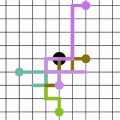We apply the power-of-two-choices paradigm to a random walk on a graph: rather than moving to a uniform random neighbour at each step, a controller is allowed to choose from two independent uniform random neighbours. We prove that this allows the controller to significantly accelerate the hitting and cover times in several natural graph classes. In particular, we show that the cover time becomes linear in the number $n$ of vertices on discrete tori and bounded degree trees, of order $\mathcal{O}(n \log \log n)$ on bounded degree expanders, and of order $\mathcal{O}(n (\log \log n)^2)$ on the Erd\H{o}s-R\'{e}nyi random graph in a certain sparsely connected regime. We also consider the algorithmic question of computing an optimal strategy, and prove a dichotomy in efficiency between computing strategies for hitting and cover times.
翻译:我们对图表上的随机行走应用了“两选权”模式:与其在每一步上移动到一个统一的随机邻居,不如允许控制器从两个独立的统一的随机邻居中选择。我们证明这允许控制器在几个自然图形类中大大加速打击和覆盖时间。特别是,我们显示,覆盖时间在离散的托里和捆绑程度树上成为线性,在受约束度扩张器上为$\mathcal{O}(n\log\log\log n)$,在Erd\H{o}s-R\\'e}nyi 随机图上为$\mathcal{O}(n)(log\log n)$(log\log n}2),在一个小相连接的系统中。我们还考虑计算最佳策略的算法问题,并证明在计算打击和覆盖时间策略的效率上存在二分法。




